Help! sealant on sandstone stained and peeled - Acrylic polymer made for freeze_thaw
-
Shona
- Posts: 11
- Joined: Thu Oct 10, 2013 10:43 am
- Location: USA
Dear Tony and fellow forum folks,
I have read everywhere on the site including archives and used search and didn't find my topic so here goes:
I am asking about a reaction from the polymer on Red and pink sandstone flags (quarried in the Western US area), which was laid on hard ground with barrier, gravel and sand base. The installer said he would 'clean' the stones and asked that I trust him. I did oversee the job but didn't hover for the polymer sealing. The polymer instructions are to apply it to the joints and squeegee (wipe with rubber like screeding) the excess off the top of flags. They used a blower to move the excess off. This was also done after he used a crop burner (flame) to further dry the flags and joints since it rained lightly a few days before. The top sand applied was also a bit damp.
RESULT:
The result of our patio sealing by an installer is a disaster.
1. A day or two after sealing, the polymer came up onto the surface of the stone and peeled and cracked, staying white (or didn't penetrate).
2. 90 percent of the stones (Cherokee red and pink sandstone) got discolored and stained with gray, brown and other colors which are NOT the colors of the flagstone.
3. I just learned from internet research that the black spots on sandstone is fungus....so now it's sealed in and I'm concerned I can't get it out.
4. There are strange bumps in a 'drip' pattern on some of the stones.
So I'm guessing there was something in the stone that caused this, or failed polymer? A bad batch? Did the polymer react to the heat applied by flame? I don't know how hot it was, but there were burn spots in a few places. My installer said this was the third time the discoloration and peeling happened this year, but in many years he has not seen it before this year. I wish he would have tested it if I was the third time!!!
I have researched many articles on stone, geology, and scientific articles (over my head) on the dissolution effect when polymer fails. It didn't really help, except to learn that polymer is affected by heat.
I want to strip the polymer off.
QUESTIONS: I understand there is a recommended product to remove the polymer. It's not that available across the pond. I'll check with the company that makes the polymer we used. I read some conservation articles and it seems that if one doesn't use nasty chemicals, it doesn't all come off. I'm sure I can do this before our rains and snow come.
2. Will the stains come off?
3. Are there any ideas about what caused the staining and peeling?
4. Do I need to talk to a chemist, or have my stones tested?
5. Can I get the fungus out of the stones after (if I can) get the polymer off?
6. Did the polymer react to the heating of the stones?
7. Should the installer have cleaned the fungus out, or chosen other stones? Some say seal the stones before placing them.
I am mostly frustrated at the milky white appearance on some flags, peeling of polymer, and staining and discoloration of the flags.
I will send photos to you Tony, and perhaps you can post the ones you feel are more relevant.
MORE INFO:
Installer heated the patio with a crop burner (a flame) because the stones were damp and the sand joints needed more drying.
Polymer was applied before sunset in 50 - 60 degrees F.
THANK YOU!!!
The installer told me that the polymer rep told him that the stones had 'acid' in them and that is what repelled the polymer. Not so sure about that.
I have photos if you need them.
THANK YOU SO MUCH!
Shona
We saved for years to have a new patio, as I was tripping and falling on our previous concrete pavers with gaps in them, installed right on the dirt! (before we had the house)
I also think the installer rushed a bit.
THANK YOU!!!!
I have read everywhere on the site including archives and used search and didn't find my topic so here goes:
I am asking about a reaction from the polymer on Red and pink sandstone flags (quarried in the Western US area), which was laid on hard ground with barrier, gravel and sand base. The installer said he would 'clean' the stones and asked that I trust him. I did oversee the job but didn't hover for the polymer sealing. The polymer instructions are to apply it to the joints and squeegee (wipe with rubber like screeding) the excess off the top of flags. They used a blower to move the excess off. This was also done after he used a crop burner (flame) to further dry the flags and joints since it rained lightly a few days before. The top sand applied was also a bit damp.
RESULT:
The result of our patio sealing by an installer is a disaster.
1. A day or two after sealing, the polymer came up onto the surface of the stone and peeled and cracked, staying white (or didn't penetrate).
2. 90 percent of the stones (Cherokee red and pink sandstone) got discolored and stained with gray, brown and other colors which are NOT the colors of the flagstone.
3. I just learned from internet research that the black spots on sandstone is fungus....so now it's sealed in and I'm concerned I can't get it out.
4. There are strange bumps in a 'drip' pattern on some of the stones.
So I'm guessing there was something in the stone that caused this, or failed polymer? A bad batch? Did the polymer react to the heat applied by flame? I don't know how hot it was, but there were burn spots in a few places. My installer said this was the third time the discoloration and peeling happened this year, but in many years he has not seen it before this year. I wish he would have tested it if I was the third time!!!
I have researched many articles on stone, geology, and scientific articles (over my head) on the dissolution effect when polymer fails. It didn't really help, except to learn that polymer is affected by heat.
I want to strip the polymer off.
QUESTIONS: I understand there is a recommended product to remove the polymer. It's not that available across the pond. I'll check with the company that makes the polymer we used. I read some conservation articles and it seems that if one doesn't use nasty chemicals, it doesn't all come off. I'm sure I can do this before our rains and snow come.
2. Will the stains come off?
3. Are there any ideas about what caused the staining and peeling?
4. Do I need to talk to a chemist, or have my stones tested?
5. Can I get the fungus out of the stones after (if I can) get the polymer off?
6. Did the polymer react to the heating of the stones?
7. Should the installer have cleaned the fungus out, or chosen other stones? Some say seal the stones before placing them.
I am mostly frustrated at the milky white appearance on some flags, peeling of polymer, and staining and discoloration of the flags.
I will send photos to you Tony, and perhaps you can post the ones you feel are more relevant.
MORE INFO:
Installer heated the patio with a crop burner (a flame) because the stones were damp and the sand joints needed more drying.
Polymer was applied before sunset in 50 - 60 degrees F.
THANK YOU!!!
The installer told me that the polymer rep told him that the stones had 'acid' in them and that is what repelled the polymer. Not so sure about that.
I have photos if you need them.
THANK YOU SO MUCH!
Shona
We saved for years to have a new patio, as I was tripping and falling on our previous concrete pavers with gaps in them, installed right on the dirt! (before we had the house)
I also think the installer rushed a bit.
THANK YOU!!!!
-
Tony McC
- Site Admin
- Posts: 8346
- Joined: Mon Jul 05, 2004 7:27 pm
- Location: Warrington, People's Republic of South Lancashire
- Contact:
This polymer is a sealant, I take it? If so, do you know the types (I'm guessing acrylic) and the brand name. It's unlikely we have it over here, but it would enable me to read up on it before making a fool of meself in public.
The one sentence that screams out at me from your post is....
"Installer heated the patio with a crop burner (a flame) because the stones were damp and the sand joints needed more drying."
...that sounds like a recipe for disaster and the bollocks (British/Irish technical term) about the stone having an acid content is a pathetic, nonsensical excuse intended to baffle you with science.
The one sentence that screams out at me from your post is....
"Installer heated the patio with a crop burner (a flame) because the stones were damp and the sand joints needed more drying."
...that sounds like a recipe for disaster and the bollocks (British/Irish technical term) about the stone having an acid content is a pathetic, nonsensical excuse intended to baffle you with science.
Site Agent - Pavingexpert
-
RAPressureWashing
- Posts: 985
- Joined: Wed Aug 15, 2007 3:02 pm
- Location: Staines Surrey
- Contact:
Sounds to me like the guy has tried to fast dry the paving with his "crop burner" :p and the paving wasn't dry completely, only the surface, then applied the sealer which has failed, rush job IMO.
Roger Oakley BDA(Europe)Member 2006
R&A Pressure Washing Services Ltd
info@rapressurewashing.co.uk
www.rapressurewashing.co.uk
R&A Pressure Washing Services Ltd
info@rapressurewashing.co.uk
www.rapressurewashing.co.uk
-
Tony McC
- Site Admin
- Posts: 8346
- Joined: Mon Jul 05, 2004 7:27 pm
- Location: Warrington, People's Republic of South Lancashire
- Contact:
Here's the photies.....
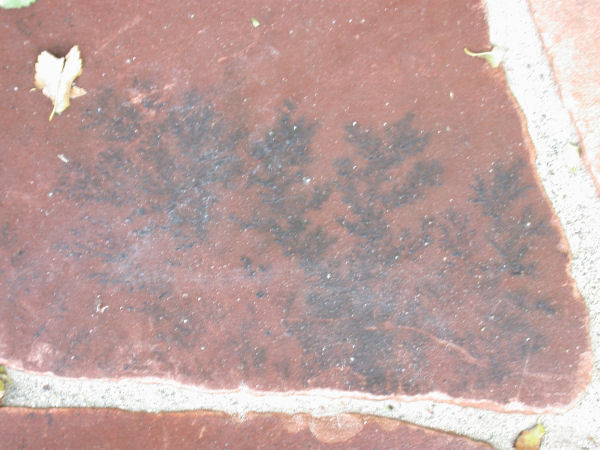
These are dendrites, a peculiar formation of iron oxide (rust) with other minerals. It's not uncommon in red sandstones.
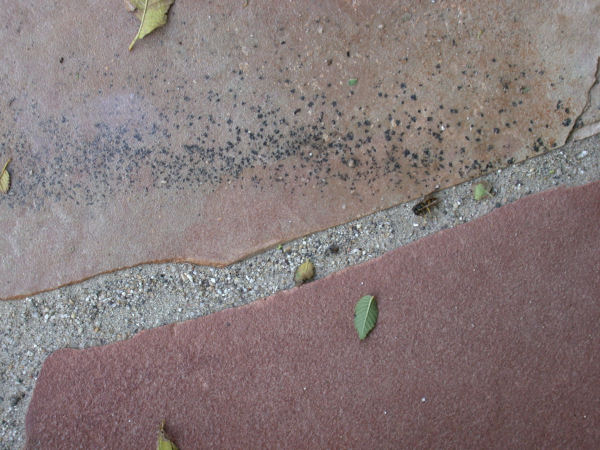
I reckon this is something similar, albeit in a speckled pattern. Just why it's not apparent close to edges is a bit of a mystery.
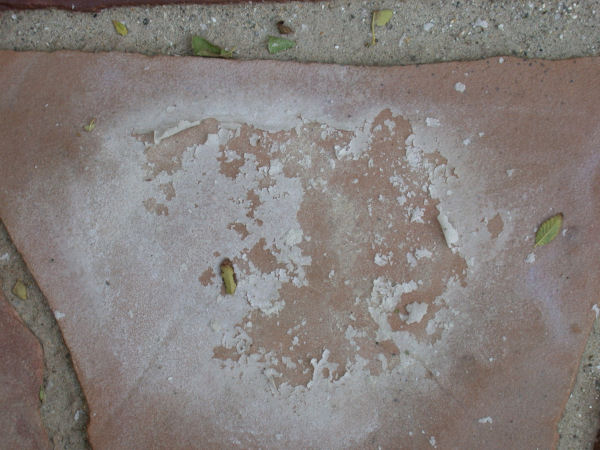
That looks like sealnt that has been allowed to pool on one flagstone
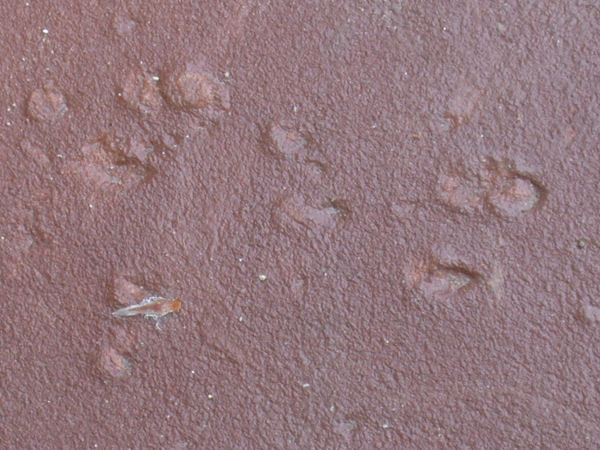
These are turbidites, a common feature in many desert/red sandstones. They are a completely natural feature, a trace fossil left by a worm or insect burrowing ion the sand before it turned into rock.
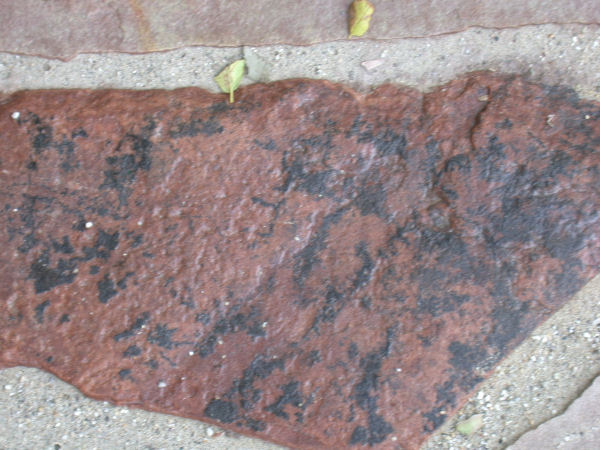
Once again, I suspect this is iron deposits, and a natural feature but one that may not always be desirable
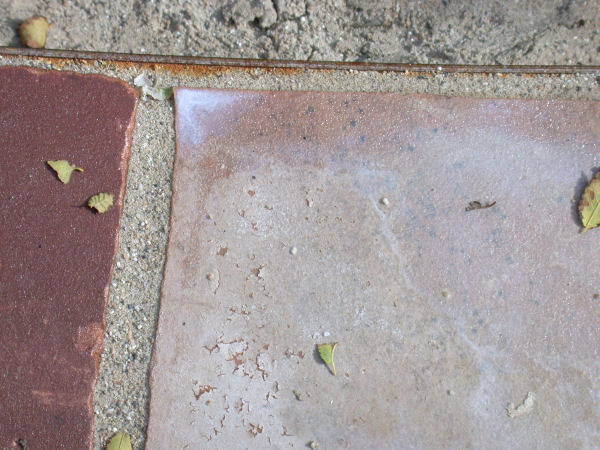
More sealant residue
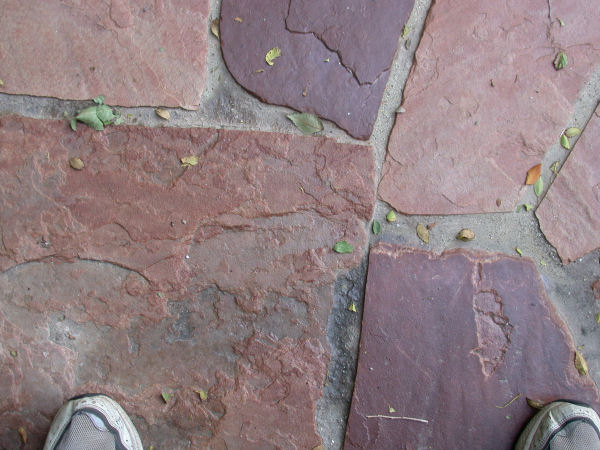
Not sure what this is intended to show, other than natural colour variation on red sandstones
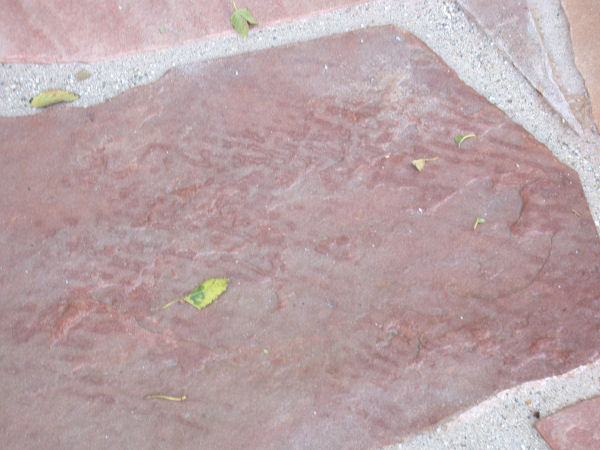
Squeegee marks?
....any other opinions?

These are dendrites, a peculiar formation of iron oxide (rust) with other minerals. It's not uncommon in red sandstones.

I reckon this is something similar, albeit in a speckled pattern. Just why it's not apparent close to edges is a bit of a mystery.

That looks like sealnt that has been allowed to pool on one flagstone

These are turbidites, a common feature in many desert/red sandstones. They are a completely natural feature, a trace fossil left by a worm or insect burrowing ion the sand before it turned into rock.

Once again, I suspect this is iron deposits, and a natural feature but one that may not always be desirable

More sealant residue

Not sure what this is intended to show, other than natural colour variation on red sandstones

Squeegee marks?
....any other opinions?
Site Agent - Pavingexpert
-
lutonlagerlout
- Site Admin
- Posts: 15184
- Joined: Fri Aug 04, 2006 12:20 am
- Location: bedfordshire
-
RAPressureWashing
- Posts: 985
- Joined: Wed Aug 15, 2007 3:02 pm
- Location: Staines Surrey
- Contact:
Shona,
Do you have the name/brand of sealer used, also the name of the pointing product as this look's from the photos one of the polymeric products you guys use over there.
Where about's in the USA are you.
Do you have the name/brand of sealer used, also the name of the pointing product as this look's from the photos one of the polymeric products you guys use over there.
Where about's in the USA are you.
Roger Oakley BDA(Europe)Member 2006
R&A Pressure Washing Services Ltd
info@rapressurewashing.co.uk
www.rapressurewashing.co.uk
R&A Pressure Washing Services Ltd
info@rapressurewashing.co.uk
www.rapressurewashing.co.uk
-
PavingSuperstore
- Posts: 154
- Joined: Mon Oct 07, 2013 11:23 am
- Contact:
-
London Stone Paving
- Posts: 2199
- Joined: Mon May 10, 2010 1:07 pm
- Location: Surrey
- Contact:
-
RAPressureWashing
- Posts: 985
- Joined: Wed Aug 15, 2007 3:02 pm
- Location: Staines Surrey
- Contact:
Steve
if the OP comes back and tells us what has been used then we all might be able to help, but from my view, it look's like acrylic type sealer, seen this before to much moisture in the paving so a fail,sealed to quick, but a PU sealer can go this route as well, again to much moisture in the paving so the damp is trying to get out, and heat/warmth hitting the surface so again a fail with the sealer, as it in breaks up when it finally cures.
Shame people try to rush sealing without understanding how sealing works, If it isn't dry naturally don't seal, don't cut corners, don't try to fast dry (crop burners, blowing, heat guns etc) as this is all surface drying, and the moisture will win out by coming to the top of the surface.
if the OP comes back and tells us what has been used then we all might be able to help, but from my view, it look's like acrylic type sealer, seen this before to much moisture in the paving so a fail,sealed to quick, but a PU sealer can go this route as well, again to much moisture in the paving so the damp is trying to get out, and heat/warmth hitting the surface so again a fail with the sealer, as it in breaks up when it finally cures.
Shame people try to rush sealing without understanding how sealing works, If it isn't dry naturally don't seal, don't cut corners, don't try to fast dry (crop burners, blowing, heat guns etc) as this is all surface drying, and the moisture will win out by coming to the top of the surface.
Roger Oakley BDA(Europe)Member 2006
R&A Pressure Washing Services Ltd
info@rapressurewashing.co.uk
www.rapressurewashing.co.uk
R&A Pressure Washing Services Ltd
info@rapressurewashing.co.uk
www.rapressurewashing.co.uk
-
London Stone Paving
- Posts: 2199
- Joined: Mon May 10, 2010 1:07 pm
- Location: Surrey
- Contact:
-
RAPressureWashing
- Posts: 985
- Joined: Wed Aug 15, 2007 3:02 pm
- Location: Staines Surrey
- Contact:
Absolutely, book them in for next year when the conditions are more suited to sealing, paving won't suffer and you don't have the stress or headache of a failed sealer.London Stone Paving wrote:That's very good advice roger. We see a lot of people at this time of year rushing to get there patio sealed. The reality is that the ideal sealing conditions for this year have now passed and its better just to wait until spring
October to March over here, then forget sealing.
Roger Oakley BDA(Europe)Member 2006
R&A Pressure Washing Services Ltd
info@rapressurewashing.co.uk
www.rapressurewashing.co.uk
R&A Pressure Washing Services Ltd
info@rapressurewashing.co.uk
www.rapressurewashing.co.uk
-
Shona
- Posts: 11
- Joined: Thu Oct 10, 2013 10:43 am
- Location: USA
Dear EVERYONE who replied to my desperate plea:) Thank you so much for your support and expert opinions. Sorry I haven't been here in a few days. The product is called 'Interlock'. It seems like it is a small company and local to Utah, U.S. I have asked to talk to a chemist there but the owner(?)/rep says they don't have one. I have emailed him all the photos of white and cracking patio when wet, after rain, after cold, and it is all disastrous looking. I was concerned about the surface heating, and I agree, it may have been wet below. I wonder why it seemed to get milky and crack on the rose colored sandstone and not the Cherokee Red sandstone. In my lay opinion, the rose sandstone seems thicker and more striated (sedemented would be the word?), but maybe even though it is thicker, maybe that means that it was less absorbent. I will send Tony a photo of the whole patio (you'll also see my first attempt at pebble mosaic!). Today I went out to look and I saw some sand joints that looked darker.....like they were wet. Wow, sure enough when I touched it, the sand depressed and was not bonded, so that means that the polymer didn't absorb into some of the sand as well, although those were small spots. It may get into freezing temps tonight....and I wonder what will happen to sandstone with failed polymer after we have had some rain and now it is getting quite cold (and still wet).
Oh yes, you also asked if the product is a polymeric sand. No, it is not. The builder's sand is in the joints and the polymer is a thin liquid. It sets up quite fast if you get it on your fingers (ugh). It was applied with a manual pump sprayer and applied into the sand joints from about a 6" height maybe. The other installer followed with a handheld gas blower which 'moved' the excess off the top of the flagstone. The instructions DO SAY to use a squeegee. I will post the website so you can see the instructions. I haven't heard back from 'them' yet.
Thank you so much, again, for your great advice.
I tried some other liquid polymer products (from larger companies) and the consistency and appearance is similar, but again, this company claims this polymer has been formulated for our freeze thaw cycles, and somewhat permeable, as I suppose all the polymers are. The other companies I tried in a test sample (with only a small amount applied from a spray bottle) are Nano Pave (www dot nano-pave dot com) and I don't remember the other one.
The product that was used on my new patio was on the site: www dot interlockpro dot com
The specific information on the product provided is at www dot interlockpro dot com forward slash paver-shield dot php
I am a bit concerned about trying to powerwash as much off (gently) as possible, since sandstone is so soft, and the weather is getting colder, but we should have a warmer end of the week this week. Also, I wonder if the polymer will stain if left on for the winter. It really did discolor the flagstone.
Thank you, Tony, for posting the photos. I will now email you the requested 'larger view' of the whole project.
Looking forward to your replies.
All the best,
Shona
Yes, he was in a bit of a rush....he wanted the second half of his payment! I'm also a bit concerned about his other projects and the other folks waiting for their projects to be sealed.
This person said he is trained as a mason, and he also installed the flagstone. We had someone else install the edging but we let them go because they charged by the hour:(
The overall design is mine:)
Oh yes, you also asked if the product is a polymeric sand. No, it is not. The builder's sand is in the joints and the polymer is a thin liquid. It sets up quite fast if you get it on your fingers (ugh). It was applied with a manual pump sprayer and applied into the sand joints from about a 6" height maybe. The other installer followed with a handheld gas blower which 'moved' the excess off the top of the flagstone. The instructions DO SAY to use a squeegee. I will post the website so you can see the instructions. I haven't heard back from 'them' yet.
Thank you so much, again, for your great advice.
I tried some other liquid polymer products (from larger companies) and the consistency and appearance is similar, but again, this company claims this polymer has been formulated for our freeze thaw cycles, and somewhat permeable, as I suppose all the polymers are. The other companies I tried in a test sample (with only a small amount applied from a spray bottle) are Nano Pave (www dot nano-pave dot com) and I don't remember the other one.
The product that was used on my new patio was on the site: www dot interlockpro dot com
The specific information on the product provided is at www dot interlockpro dot com forward slash paver-shield dot php
I am a bit concerned about trying to powerwash as much off (gently) as possible, since sandstone is so soft, and the weather is getting colder, but we should have a warmer end of the week this week. Also, I wonder if the polymer will stain if left on for the winter. It really did discolor the flagstone.
Thank you, Tony, for posting the photos. I will now email you the requested 'larger view' of the whole project.
Looking forward to your replies.
All the best,
Shona
Yes, he was in a bit of a rush....he wanted the second half of his payment! I'm also a bit concerned about his other projects and the other folks waiting for their projects to be sealed.
This person said he is trained as a mason, and he also installed the flagstone. We had someone else install the edging but we let them go because they charged by the hour:(
The overall design is mine:)
Shona
-
Shona
- Posts: 11
- Joined: Thu Oct 10, 2013 10:43 am
- Location: USA
Another reply to "Chief tea boy". I am not familiar with Indian Sandstone here in Utah. I looked at some UK sites and it seems like it comes in lots of surface variations. I found out well into our job, that the workers at the quarry get paid per pallet so they often 'hide' 'bad' stone in the center of the pallet:( Our installer was very nice and went back and forth on many days switching out flagstones that were 'unacceptable', that is, having great variation in thickness, or undesirable color, or very 'flakey.' I also, as I said, had no IDEA about fungus in sandstone. The installer, as someone said, gave a poor excuse that the black was "characteristic" of the stone, and the rep for the polymer company said there was acid in the stone, which I didn't believe at the outset. Thanks again. I'm just feeling chatty and not hearing back from my installer or the polymer company yet, but my husband will call tomorrow.
I wonder what the rep will offer us, (we want the polymer replaced) but maybe wait until next year. And if I had to do it all over again, I would be more selective of the stone and purchase 'clean' stone that had fungus removed, or not present to start with.
Have a great day,
Shona
I wonder what the rep will offer us, (we want the polymer replaced) but maybe wait until next year. And if I had to do it all over again, I would be more selective of the stone and purchase 'clean' stone that had fungus removed, or not present to start with.
Have a great day,
Shona
Shona
-
PavingSuperstore
- Posts: 154
- Joined: Mon Oct 07, 2013 11:23 am
- Contact:
I wouldn't think leaving the sealer over Winter is going to do any harm to the stone. Maybe see what's left of it come Spring and start again. I would anticipate some of it cracking and peeling away (the sealer and not the stone!) which will be a help as you will need to remove it all before resealing. From what you've described, it sounds very much like some of the stone is more porous than other pieces and therefore was probably not completely dry before sealing. Paving normally has to have less than 2% moisture prior to sealing and of course, the moisture can come from the mortar as well as the stone itself. You will need to check with the manufacturer what process you should use for removing their sealer and then maybe do a little research on different types of sealer available. Some will leave a permanent wet look which is often considered too glossy for natural stone whereas other types of sealant have little effect on the colouring of the stone, but fundamentally protect the stone against grease from BBQs for instance, and water or algae. Also, don't worry about the stone remaining partially unsealed over Winter - it's not essential to seal paving at all, just sometimes a preference if it's exposed to maybe grease, heavy foot traffic, overhanging trees etc
Regards,
George
Regards,
George